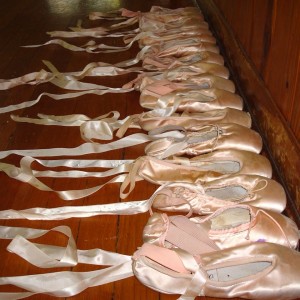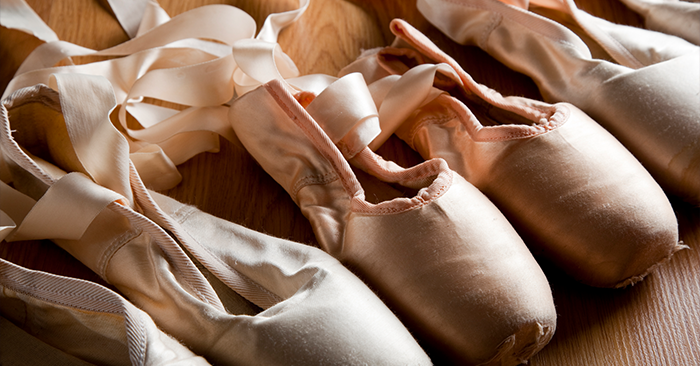It’s finally time to get your first pointe shoes!! In this article, we’ll walk through the process of finding a fitter, buying the supplies you’ll need for pointe, and then a few things to think about as you start dancing in your new shoes.
Ask the Right Questions
If you’re headed to buy your first pointe shoes, that means that you’ve gotten approval from your teacher and are ready to take the next big step in your dance journey! First thing’s first: you’ll need to ask your teacher the right questions so you’re fully prepared for your shoe fitting.
These questions will cover your teacher’s preferences and school policies, and they’ll be really valuable when working with your fitter.
What kind of padding do I need?
There are a variety of padding options to cushion dancers’ feet in their pointe shoes: Ouch Pouches, other gel padding, lambswool: there are different options for different feet, and no one single magic solution. Ouch Pouches are an industry favorite, but it’s worth it to know about other options.
Your teacher may (or may not) have a preference for which padding works best, but may also let you know that your school requires a certain padding for its dancers. The reason you’ll need to ask about padding before your fitting is that you’ll need to use that padding at the actual fitting session.
You can choose to buy that padding ahead of time, or you can also buy it at the dance store when you arrive for your fitting. Either way, plan to be consistent. Whichever padding you use during your fitting for your first pointe shoes, you’ll to continue using in class and in performance. That consistency will maintain your shoe’s fit and will prevent injury.
What kind of shank do you prefer?
Whatever answer you get to this question needs to be taken with a grain of salt: every person is different, and every pair of feet will need different support for safe and healthy dancing. Typically the shank provides support for your foot’s arch (CPYB has some great diagrams outlining the parts of a pointe shoe) while dancing en pointe, and depending on your arch you’ll need a stronger or softer shank.
What does this have to do with your teacher? Depending on your teacher’s preference, he or she may want you to lean towards a shank that supports your foot, but also ties into your progress as a dancer. Especially for dancers new to pointe, it’s important to remember that building additional foot strength will be a part of dancing en pointe.
Depending on your teacher’s preference, he or she may want you to lean towards a shank that supports your foot, but also ties into your progress as a dancer. Especially for dancers new to pointe, it’s important to remember that building additional foot strength will be a part of dancing en pointe.
It’s a balance of dancing safely and building good technique: a softer shank will offer less support for the foot, and will help dancers to build that greater foot strength over time. Some teachers prefer that foot development as part of your dance instruction, so it’s something to keep in mind and tell your fitter when at the dance store.
Do you have a dance store you can recommend?
It’s always good to have a recommendation for a professional service like a dance shoe fitting, and if anyone will know where to find your first pointe shoes locally, it’ll be your teacher. Your teacher will be able to say “I have a great relationship with Store A” or “I haven’t had very much luck with Store B.” They might even suggest you try a store in a different city, if there are few options locally.
How much should I expect to spend on my first pointe shoes?
The last thing you want is an unpleasant surprise when you go to buy your first pointe shoes. Pointe shoes are not cheap, but they’re a critical tool for your success and SAFETY. It’s worth it to spend the money to get a great pair that fits your feet well. You should know what you’re getting into, and have an idea of what the bill will look like.
Still have some questions about the shoes in general? Check out this video that explains the anatomy of a pointe shoe:
What to Wear
It’ll be very important for the fitter to see your whole line, from your feet to your hips. It’s also important to wear the clothes you’ll have on when dancing in your shoes. What is your studio’s policy on attire while dancing en pointe: tights required? Tights optional?
Consistency is key: if your studio requires students to wear tights while dancing in their pointe shoes, then be sure to wear tights to the fitting. If you’ll eventually be performing in tights in your pointe shoes, even if you aren’t always required to dance in tights, wear the tights! And change your practice routine to include tights. Even minor changes in your footwear (like an extra little layer of fabric) can make a big difference in your shoe’s fit.
Our recommendation? Wear tights, and tighter-fitting shorts or a shorter skirt. No baggy clothing! Again, the fitter will need to see your line from your feet to your hips.
Also, make sure your toenails are trimmed prior to going to your fitting! Not too short, but definitely not too long.
In The Store
You’ve made it through the front door! Be sure to have planned for a minimum of 1 hour for your fitting, and it’s not a bad idea to even plan for 2 or 3 hours depending on the store’s available inventory. You want to try on as many different shoes as possible while you’re here.
The fitter will get right to work observing your:
- Foot size
- Foot width
- Toe shape
- Toe length
- Arch height
From there, the fitter will start pulling examples for you to try on. Since you’ve already prepared for the cost of the shoes, don’t hold back on trying on every kind you can. You want a perfect fit for your feet, so that your form develops effectively and safely.
What should that perfect fit feel like?
- Your toes should NOT overlap each other in the shoes.
- Your toes should not be scrunched for space in the shoes.
- When you go up en pointe, your feet should not feel like they are sinking into the box.
- When you go up en pointe, you should feel even distribution of weight across your toes (and not extra pressure on one toe, like your big toe)
- The shoes should “fit like a glove,” as in there’s no real wiggle room for your feet. These shoes should be very snug, and are not meant to “grow into.”
Be honest and open with your fitter, so that they have as much information as they need to help you make an informed choice. Don’t hold back in mentioning anything that feels a little off! These shoes need to be as perfect as possible so that you can practice correctly and avoid injury.
Keeping that in mind, don’t settle for a pair of shoes that you think might be ok. Even if you’ve spent a good amount of time in the store, if haven’t found a pair that you feel really GREAT about, go somewhere else and try on a few other pairs. It’s worth it for your feet (and wallet) to buy the right pair the first time.
You Made It
You made it! You’ve found a pair of shoes that fit your feet so well that you can’t wait to get them on and start dancing. BUT WAIT!
Now that you have your shoes, you need to get them approved by your teacher. Don’t wear them at home, on the way to dance, maybe don’t even take them out of the box for now. Wait until you’re in class, and your teacher asks you to try them on.
If your teacher approves, you’re all set! You can move on with sewing on the elastic and ribbons that will help secure the shoes to your feet.
If your teacher doesn’t like the fit, or thinks some key aspect needs to be adjusted, put those shoes right back in the box until you can get back to the dance store. Most dance stores will exchange pointe shoes that haven’t fit, but only if they’re in LIKE NEW condition. Even then, be sure to check with your individual store before you make a purchase.
Hope this has been helpful!


